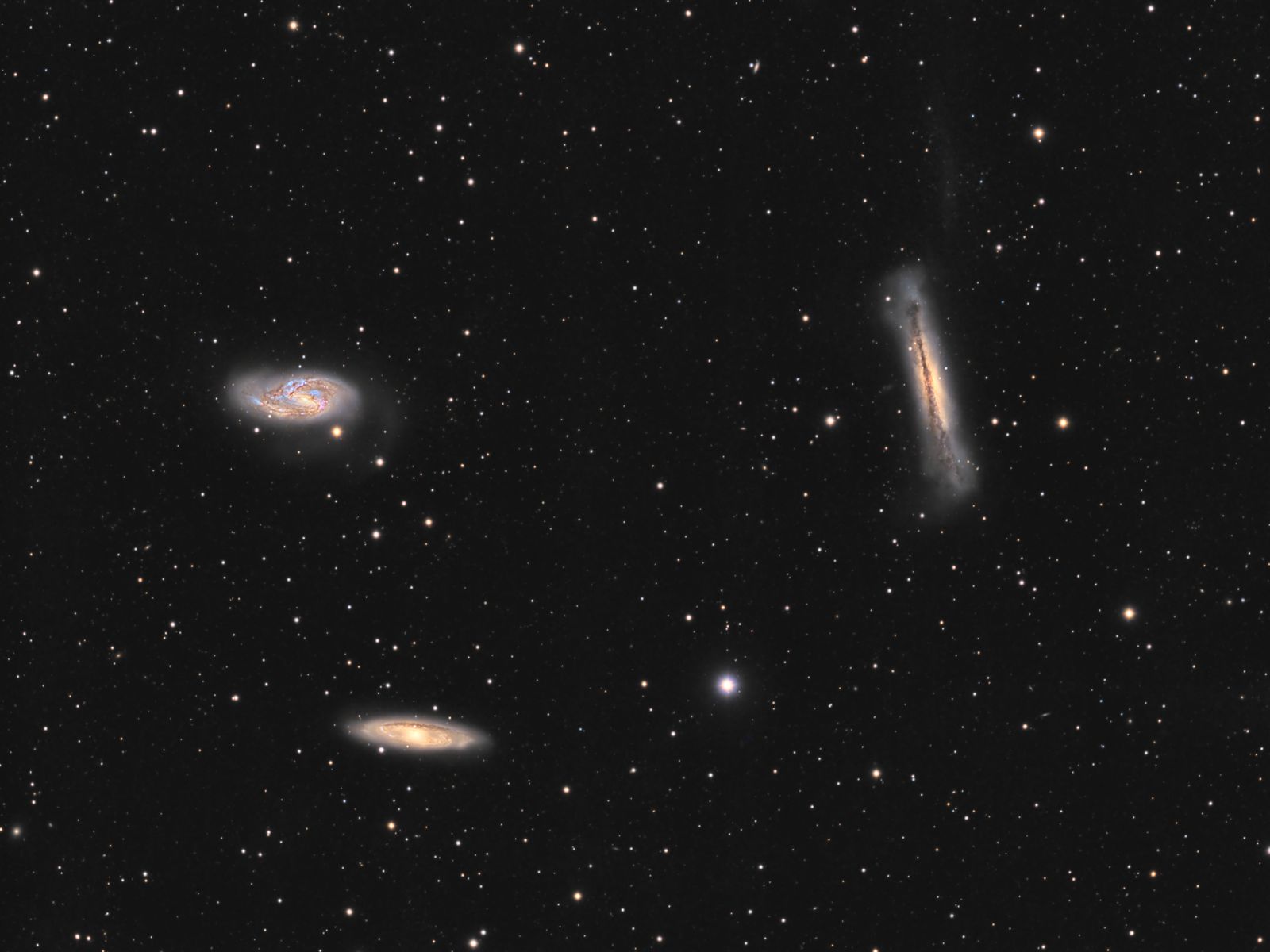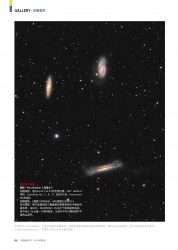The Leo Trio – M65, M66 and NGC 3628
Click image for full size version
May 14, 2019, published in May 2019 issue of Chinese National Astronomy Magazine
 M65 (lower left), M66 (upper left) and NGC3628 are three galaxies in the constellation Leo. This grouping is known as the Leo Trio or Leo Triplet. This group of galaxies is around 30 million light years away. The annotated version shows many more galaxies in the distant background, but there are still more that are not marked. M65 shows much less star formation than M66, which shows blue knots of stars and pink nebulae. It is deformed from interacting with NGC 3628, which sports a faint 300.000 light year-long tidal tail at upper right.
M65 (lower left), M66 (upper left) and NGC3628 are three galaxies in the constellation Leo. This grouping is known as the Leo Trio or Leo Triplet. This group of galaxies is around 30 million light years away. The annotated version shows many more galaxies in the distant background, but there are still more that are not marked. M65 shows much less star formation than M66, which shows blue knots of stars and pink nebulae. It is deformed from interacting with NGC 3628, which sports a faint 300.000 light year-long tidal tail at upper right.
Tekkies:
Sky-Watcher Esprit 150 f/7 refractor, QHY 16200-A camera, Optolong Ha, L, R, G and B filters, Paramount MX. Acquisition, guiding and focusing with TheSkyX. Automation with CCDCommander. All pre-processing and processing in PixInsight. Acquired from my SkyShed in Guelph. No Moon, average to above average transparency and average seeing. Data acquired March 25 – May 8, 2019.
60x10m L and 14x10m R, G and B (Total = 17hr)
Image scale 1.15 arcsec per pixel
Data Reduction and Cleanup
The BatchPreProcessing script was used to perform calibration, cosmetic correction and registration of all frames. ImageIntegration was used to make the L, R, G and B masters. DynamicCrop was used to crop all the masters identically. DynamicBackgroundExtraction was applied to each master twice, with Division followed by Subtraction.
RGB
Creation and cleanup: The R, G and B were combined to make an RGB image which was colour balanced with PhotometricColorCalibration.
Linear Noise Reduction: MultiscaleLinearTransform was used to reduce noise in the RGB image. Layer settings for threshold and strength: Layer 1: 4.0 0.8 Layer 2: 3, 0.7 Layer 3: 2., 0.6 Layer 4: 1.0, 0.2 Layer 5: 0.5, 0.1.
Stretching: HistogramTransformation was applied to make a pleasing, bright image, with background set to an intensity of approximately 0.08.
SuperLuminance
SuperLuminance: A synthetic luminance was made by combining L,R,G and B (weighted average in ImageIntegration) each DBE-processed channel.
Deconvolution: A star mask was made to use as a Local Deringing Support image. A copy of the SuperL image was stretched to use as a range mask. Deconvolution was applied (80 iterations, regularized Richardson-Lucy, external PSF made using DynamicPSF with about 30 stars).
Linear Noise Reduction: MultiscaleLinearTransform was used to reduce noise in the background areas, using an internal mask to protect bright structures. Layer settings for threshold and strength: Layer 1: 3.0 0.9 Layer 2: 2.0, 0.75 Layer 3: 1.0, 0.6 Layer 4: 0.5, 0.2.
Stretching: HistogramTransformation was applied to make a pleasing, bright image, with background set to an intensity of approximately 0.08.
Combining SuperLuminance and RGB
LRGB Combination: The SuperL was applied to the RGB image using LRGBCombine with default settings.
Additional Processing
Nonlinear Noise Reduction: TGVDenoise was used in L*a*b* mode to reduce noise with a mask used to mainly target the background areas and protect the stars (max. 1000 iterations and convergence selected for both lightness and chrominance).
Dynamic Range Compression: HDRMultiscaleTransform was applied with 6 layers using a mask to target just the M66. Using the same mask, LocalHistogramEqualization was then applied three times. First pass with a scale of 30 (max contrast 1.5, strength 0.52, 1 iteration), followed by a scale of 70 (max contrast 1.5, strength 0.22, 1 iteration) and a scale of 150 (max contrast 1.5, strength 0.33, 1 iteration).
Sharpening: MultiscaleLinearTransform was used to sharpen Layers 2 and 3 with strengths of 0.15 for both. A mask was used to limit sharpening to high-signal areas and to protect the stars and background.
Final Steps: Background, galaxy and star brightness, contrast and saturation were adjusted in several iterations using CurvesTransformation with masks as required.






Very nice detail and colour Ron
Ron, we haven’t chatted for a long time, but I just wanted to let you know how much I enjoy seeing your images… Fantastic… every time I see one I am amazed and impressed… keep up the good work!
That is an awesome image!